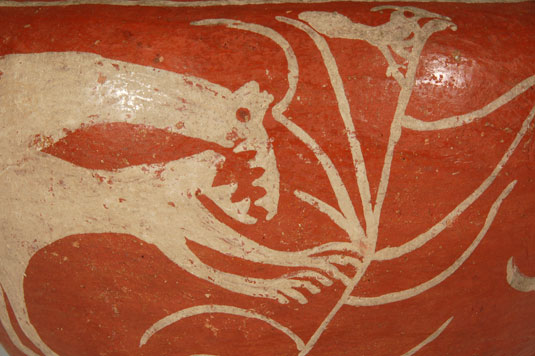Zuni Pueblo Large White-on-red Olla [SOLD]
+ Add to my watchlist Forward to Friend
- Category: Historic
- Origin: Zuni Pueblo, SHE-WE-NA
- Medium: clay, slip
- Size: 10-1/4” height x 12-3/4” diameter
- Item # C3776U SOLD
Starting as early as 1840, potters at Zuni Pueblo have been producing wares that have been classified as Zuni Polychrome. Now, 175 years later, they are still being made. During that time span, other styles have come and gone. Perhaps some potters or families tired of doing the same style and began experimenting with something new.
One of these short-lived experiments was pottery slipped in red and decorated in white. It apparently began around 1890 and ended in the 1920s, a short period of around 30 years. The new style could have been influenced by sherds from prehistoric St. Johns Polychrome from near the current Zuni Pueblo boundaries, or from prehistoric sherds being excavated at Hawikuh and Halona villages. Anthropologists could have shown sherds to potters or potters could have unearthed sherds themselves for use as temper. It is easy to see that these White-on-red wares of the late 1800s had a precedent at or near Zuni and were not a completely new innovation dreamed up by potters of the day.
Why did the phase end after such a brief period? Quite possibly because museums and dealers preferred traditional Zuni Polychrome with birds and heartline deer as more representative of traditional Zuni pottery. There was only one White-on-red vessel collected by the Smithsonian during this period, but the American Museum of Natural History collected a considerable amount.
Most of the documented examples of White-on-red pottery display geometric designs. None has a design comprised entirely of animals. This jar is painted with designs of animals and birds with just a minimal amount of plant elements. The top of the rim is black, which continues to about an inch inside the rim. The underbody is black and the base is concave. There are double framing lines at the rim, on the shoulder and near the base, all executed in white. There is a very minimal amount of black used in the design—limited to a four-branch twig on the neck and black dots on the animals on the neck.
Of the many styles of Zuni pottery made in the last 150 years, this style is among the rarest. All of the published examples of White-on-red pottery were designed with geometric patterns. This jar, decorated with animals, is incredibly rare.
There was a period in the 1920s when Indian Trader C. G. Wallace sold pottery to the Museum of New Mexico that he classified as ceremonial jars, however, they have been declared by Zuni elders as not ceremonial in nature but a hoax perpetrated by Mr. Wallace. None of those jars was executed in White-on-red, but all were Polychrome examples. There is no reason to expect that this jar is anything other than a legitimate Zuni White-on-red jar of the period. If it was one of Wallace’s hoaxes, it would be ever rarer because there are no White-on-red jars in the museum’s Wallace collection.
Condition: Black light examination does not reveal any repairs or restoration
Provenance: from the collection of a Colorado family
Reference: The Pottery of Zuni Pueblo by Harlow and Lanmon

- Category: Historic
- Origin: Zuni Pueblo, SHE-WE-NA
- Medium: clay, slip
- Size: 10-1/4” height x 12-3/4” diameter
- Item # C3776U SOLD
Adobe Gallery Recommended Reading
Adobe Gallery Recommended Items
If you are interested in this item, we would also like to recommend these other related items:



